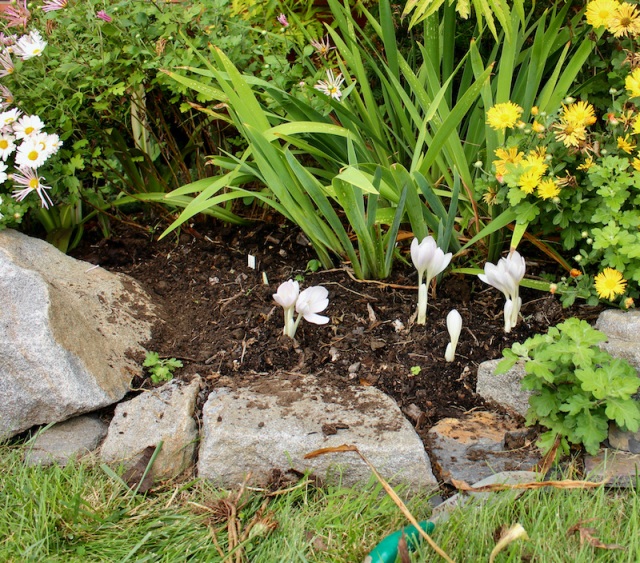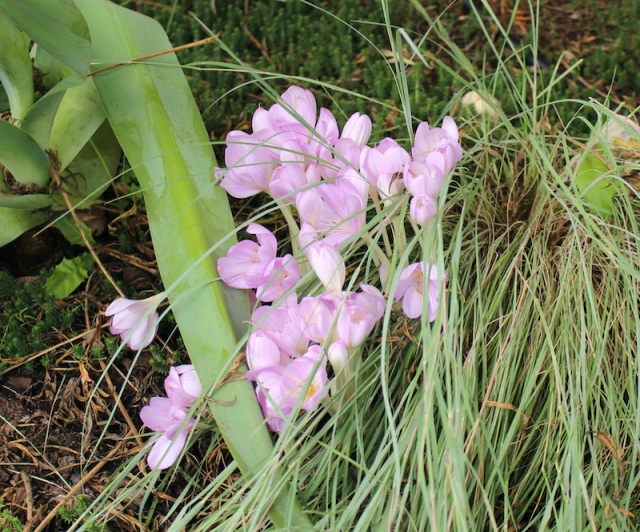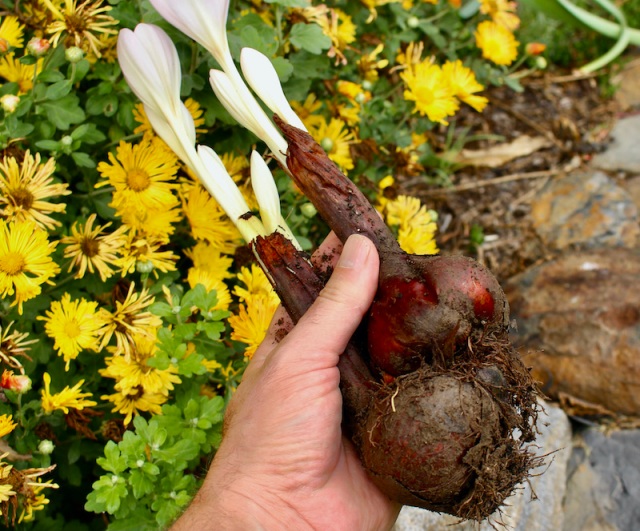I’m still in denial that summer is winding down. Every sunny day and higher temperature reading gives me hope the warmth is still holding on, but eventually I’ll need to come to terms with winter’s approach. My least favorite season is just about here and it’s time to shake off that summertime laziness and start making plans.
By least favorite season I mean fall. I dread the fall shutdown that plants go through and the first frost. Even the fall foliage looks to me like death warmed over. The best thing about fall is all the planting, and for hardy bulbs fall is the number one planting season. Although I was lost in tulips this spring, it’s daffodils that I really like, and in order to convince you to get more too I dredged up a couple pictures from the good old days of spring.

‘Accent “(1960- the year this daff was registered) is a great daffodil, it has a medium pink cup (corona) surrounded by pure white petals (perianth). The color is reliable, the plant is reliable, and it’s not too hard to find. I like fancy things too, but reliable fills a garden every spring with beautiful blooms, and in this next (over exposed) picture “accent” is paired with another great, reliable one (and one of my real favorites) “Tahiti”(1956).

There are thousands of named daffodils out there and thousands of ways to pick the best ones for your garden. Picking up a bag at the box store is fine and inexpensive and a good starting point but if you begin to get serious take a look at the Wister Award winners. It’s an American Daffodil Society award for outstanding garden daffodils and will give you a shopping list of the best daffodils for your garden.
Another good pink is “Pink Charm” (1977)

It’s a little newer than “accent” and only just a bit different with more white in the cup, but for two years I’ve been impressed with the opening color and then the later blend of pink fading to white in the center.

“Passionale”(1956) is a strong growing older pink. The flowers open with a yellowish tint to the cup which is common for these older varieties. In daffodils, pink is a relatively new color for breeders, and it’s been a long journey to separate the color and strengthen it to a ‘real’ pink color.

Daffodil breeders are always tinkering with their favorites but they generally fall into 13 divisions. To take a look at some of the fanciest and newest examples of each division click here. “Palmaries”(1973) falls into the split cup category. It’s frillier and flouncier than what I usually like, but it has been doing well in my garden.

“Newcomer”(1992) has the saturated darker pink of a newer introduction. It won’t be an easy daff to find but does show the long lasting pure colors of a modern daffodil.

“Sagitta”(2007) shows one of the newest combinations, yellow-pink. This one will likely be a very popular daffodil, so far it’s been a great grower, multiplier, and bloomer for me and I love it.

But there’s nothing wrong with a yellow trumpet daffodil. Since “King Alfred” was registered in 1899 new yellow daffodils continue to come out with stronger blooms, colors, and growth habits. The true King Alfred is tough to find today since years of slapping the name onto any yellow daffodil has muddied the water, but with so many solid yellows such as “Primeur”(1978), how can you go wrong?

My favorite group of daffodils are the cyclamineus types. Daffodils in this group all share the reflexed petals and long trumpets of the original narcissus cyclamineus species. “Peeping Tom” (1948) is on the top of my list, it’s an oldie but I love the long trumpet, wide flare and early bloom season.

Another one in this group that’s doing well for me is “Jetfire” (1966). It’s a good grower with a little orange in the trumpet (more so in cooler springs) but it’s a little stubbier and shorter than “Peeping Tom”.

If you can’t find “Peeping Tom” (I don’t see it in many catalogs any more) you could try out one of it’s children. “Wisley”(2004) comes from the seeds of a Peeping Tom cross. It’s new for me, but the flowers have a love-it or hate-it look that I’m still trying to figure out.

If you’re ever looking for daffodil info, Daff Seek pretty much has it all. It’s the searchable database of the American Daffodil Society and has photos and information on most registered daffodils…. plus interesting tidbits such as daffodil lineage and breeding info.
My latest color craze has been the yellow red combo. “Serola”(1986) is a great one that multiplies well, doesn’t fade in the sun, and is bright!

“Montego” (1968) has the same colors in a smaller rim of red. I might have gone overboard with this color range in the last few years but I really do like them.

If you’re unsure where to start with your own daffodil quest, but ready to move past the generic offerings, start with Brent and Becky’s. Even if you end up ordering elsewhere, they probably offer the best selection of good varieties and don’t carry the duds. Some of the best sources for bulk daffodils are Van Engelen and Colorblends. Just be careful, before you know it you’ll be looking up the specialists such as Mitsch’s and Cherry Creek and really killing your gardening budget.
Ok one more yellow-red. “Molten Lava” (1987) has slightly more subtle coloring, but still rich tones.

White never goes out of style and “Misty Glen” (1976) is a great daffodil in white. Over 40 other registered daffodils trace their roots to this variety and it’s won many awards. It’s one of the best daffodils.

If you still don’t feel the need to add more daffodils, here’s another try. The small cupped daffodils such as “excitement” (2001) also come in all kinds of color combos just like the big guys.

Beyond the big and little cups and the trumpets there are still thousands of “other” daffodils out there. They’re all just different expressions of the genus Narcissus. The name daffodil is just a common name most people apply to the bigger trumpet sorts but it works for all of them.
Some of the other types have unique traits that can be traced back to one of the original narcissus species. “Geranium” (pre 1930) is a reliable, hardy tazetta type which shows the clustered blooms and fragrance of this of this group. I might put this one on my top 10 best daffodil list, but with so many new types to distract me, I sometimes forget about the multiple award winners like Geranium.

Paperwhites are a well known member of the tazetta group, they’re just not hardy enough to grow up in this part of Pennsylvania. One that does suffer through is “Erlicheer” (pre 1951), it’s listed as a double but tazetta blood runs through it’s veins. The problem for me with Erlicheer is its early sprouting habit anytime there’s a break in winter temperatures. You can see how all the leaf tips have been burnt by cold snaps that came along after growth started. Too much cold combined with too active growth will eventually kill these. Sometimes erlicheer is sold as a “summer daffodil” because they don’t need the deep freeze of winter in order to bloom. You can plant them in the spring, have summer flowers, but they’ll be back to normal spring flowering the following year.

I never meant for this to be such a long post, but daffodils are so easy to grow…… and I admit I’m slightly addicted.
Here’s an example of one of the poeticus types. “Pentucket” (pre 1946) might be hard to find, but there are several look alikes out there. Poeticus daffodils (the Poet narcissus) have been grown since ancient times and are most likely the daffodil referenced in Greek poetry and myth. Today they are grown by the perfume industry for the narcissus oil they produce and apparently it’s one of the most popular fragrances…. oddly enough I don’t pick up much scent in these.

So plan ahead for spring and get some more daffodils in the ground! Even if it’s a dainty non-daff like “Baby Boomer” (pre 2008) they’re all equally easy to plant.

I find the easiest method to plant daffodils is to take out the big shovel, scoop out one or two shovel-fulls of dirt, dump the bulbs in, and cover. You don’t need to set the bulbs correctly (although I usually do put them pointy side up) and your regular soil should be fine without improvements, just get them in the ground!
Good luck, and I’d love to hear how your bulb ordering and planting is going:)























